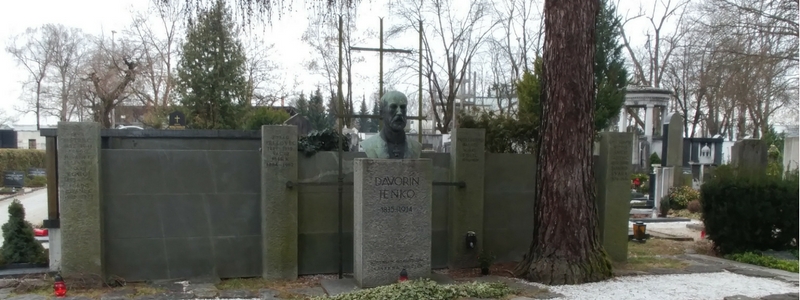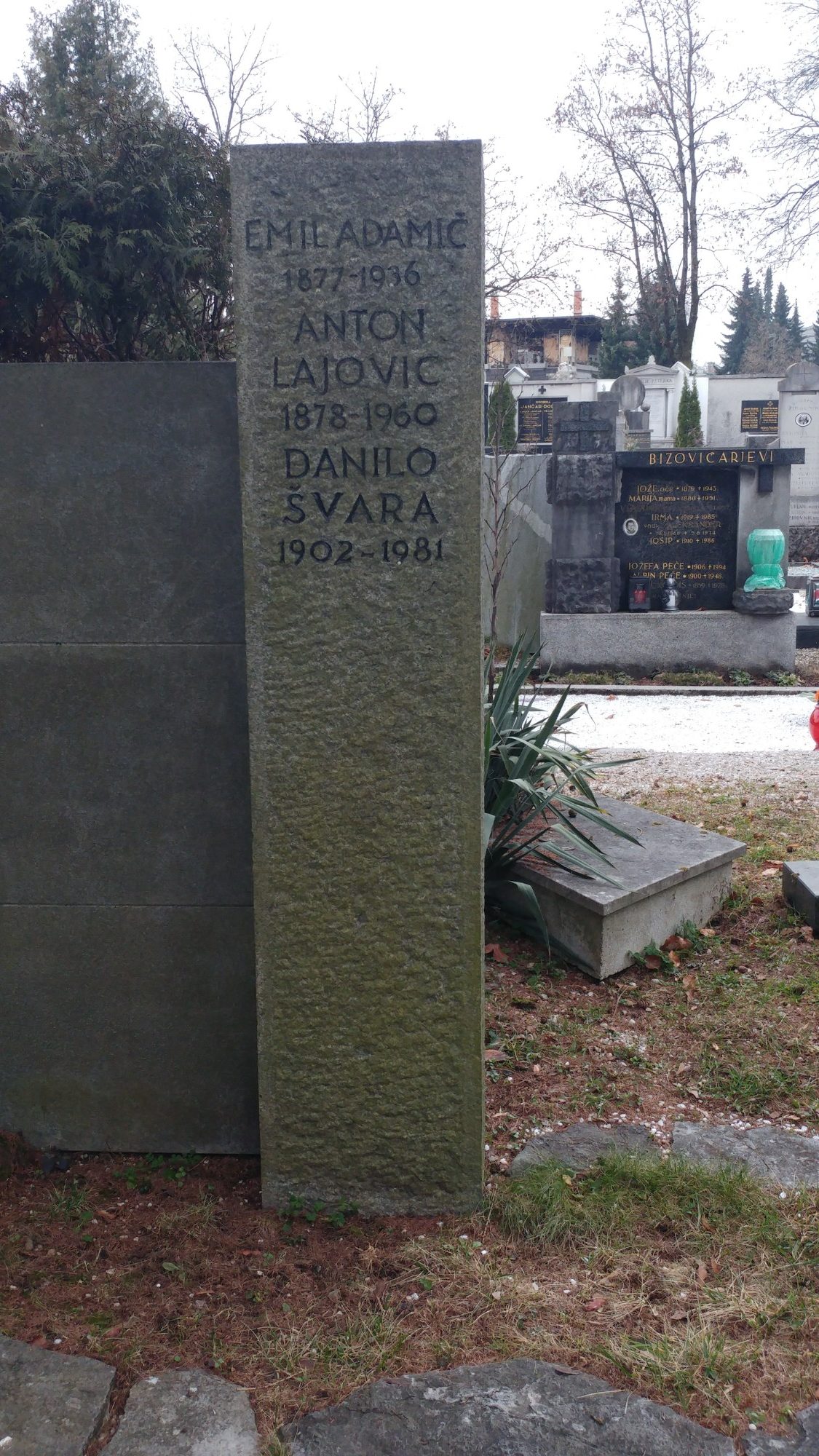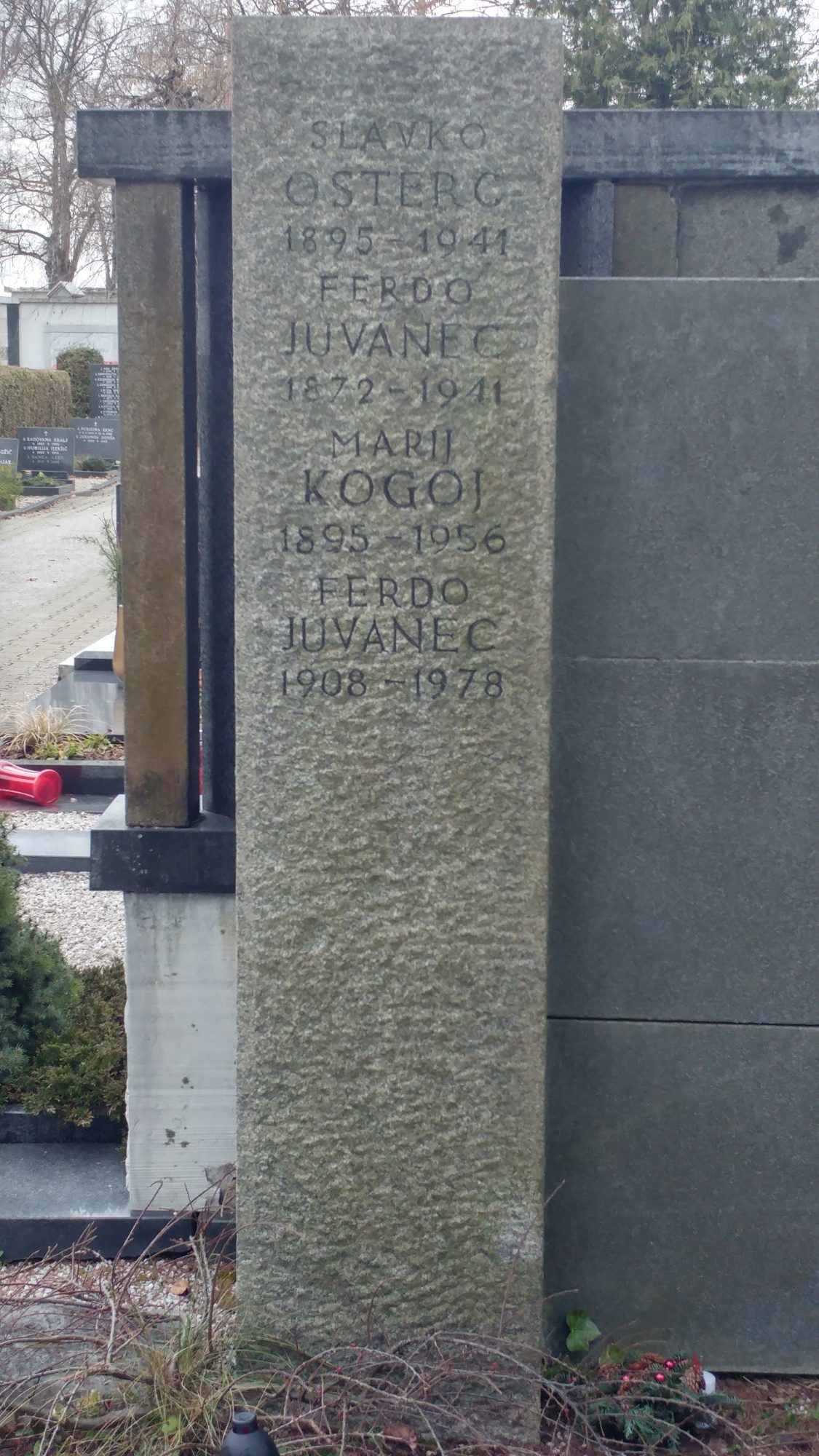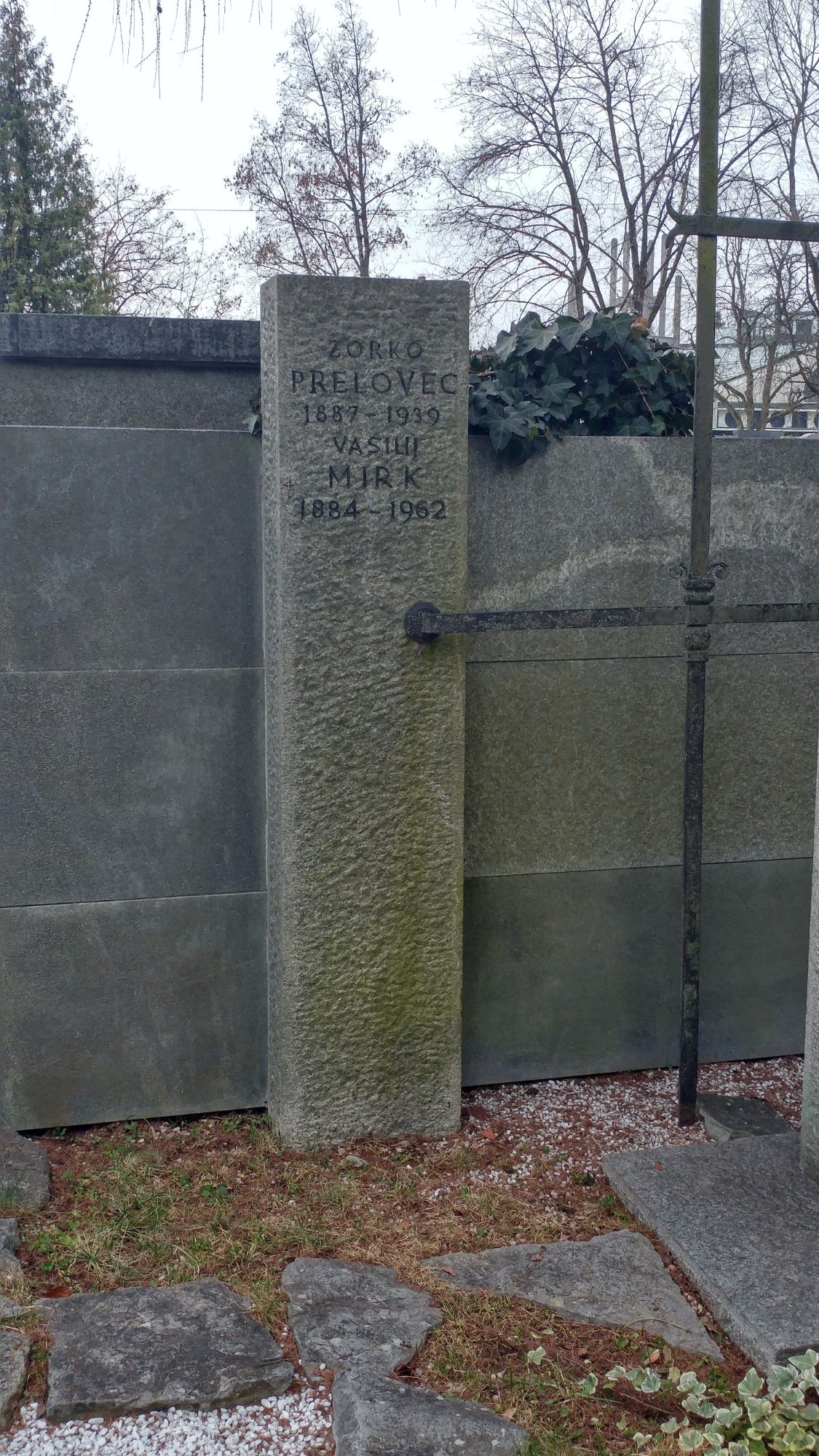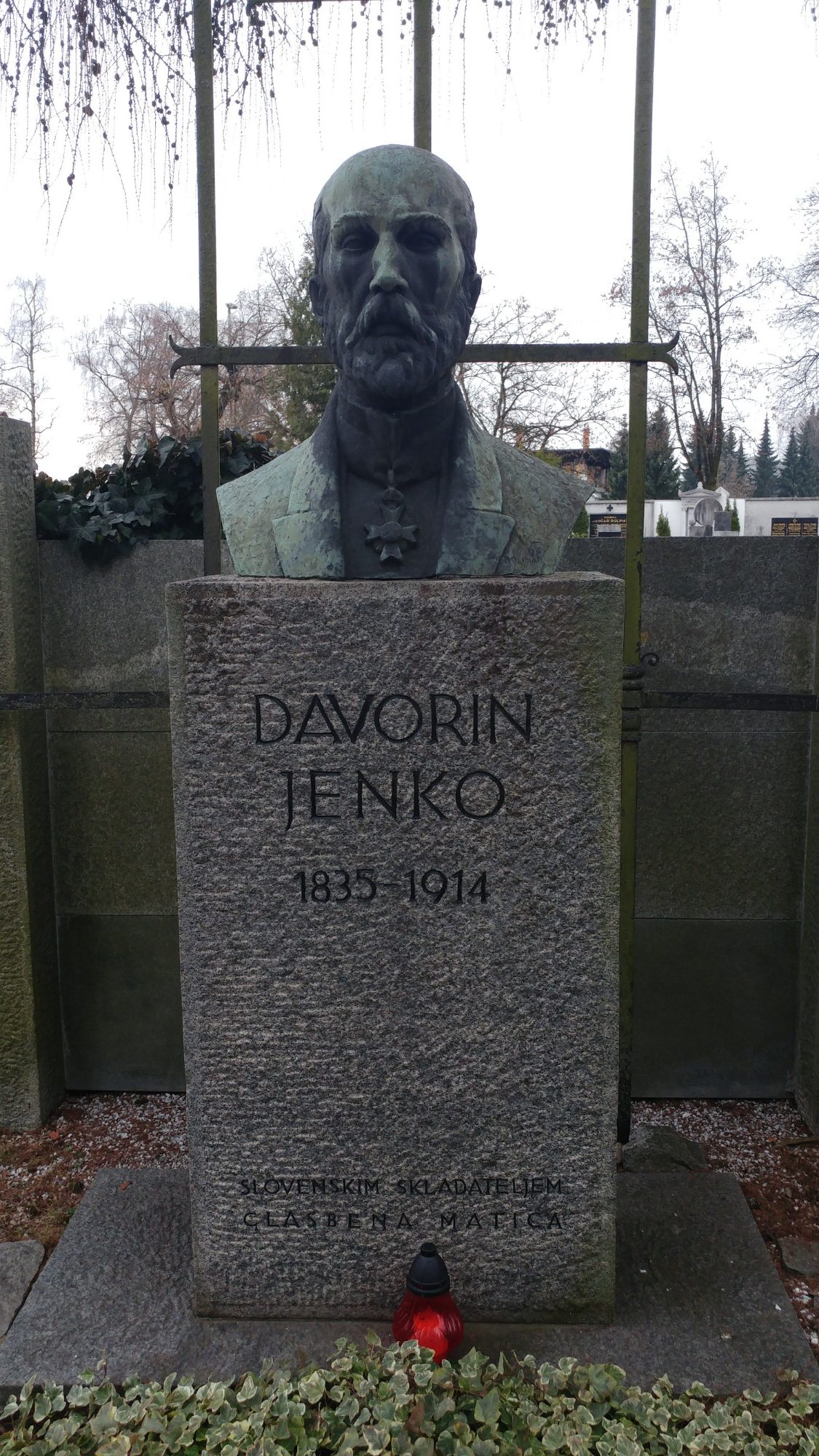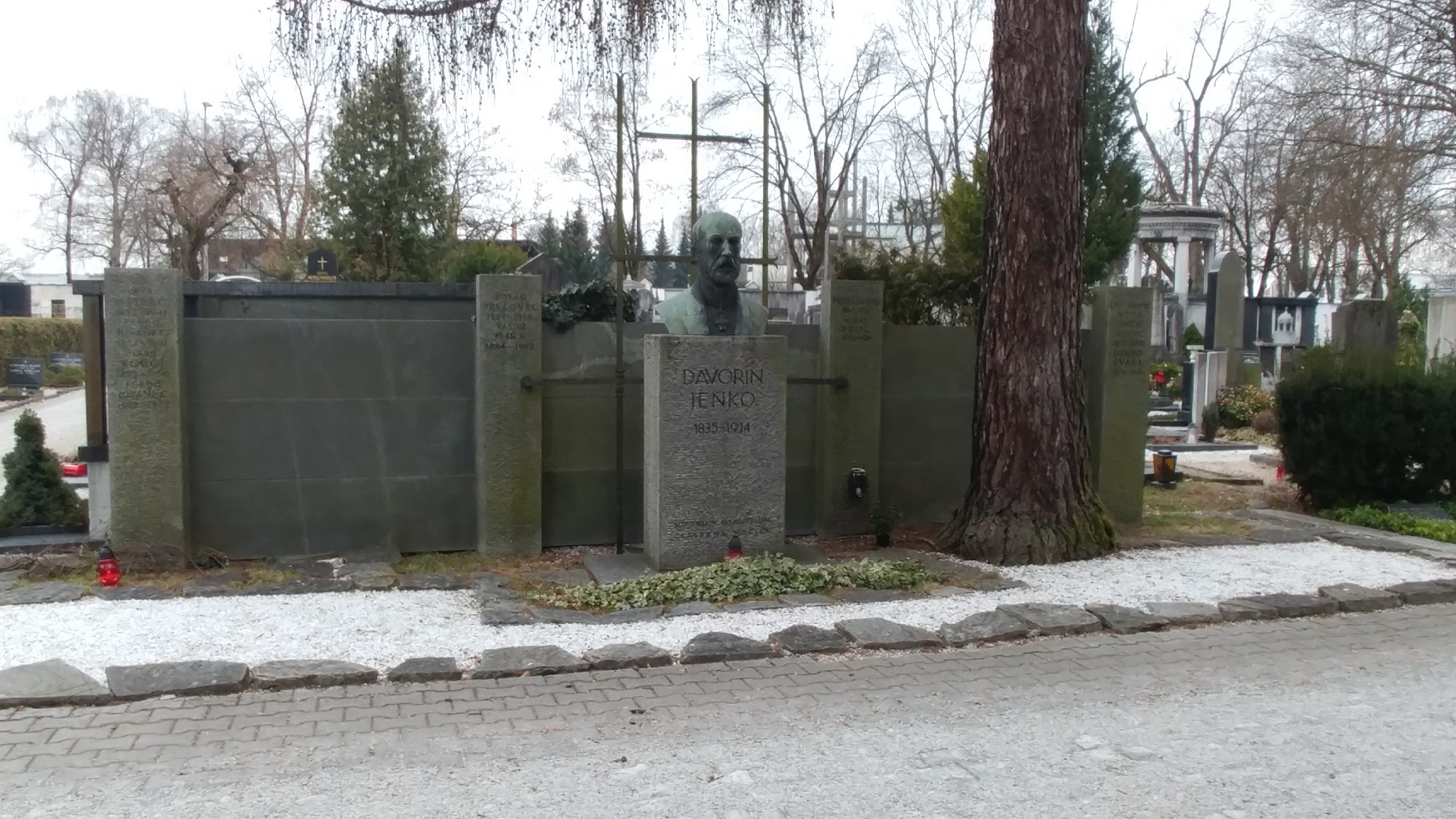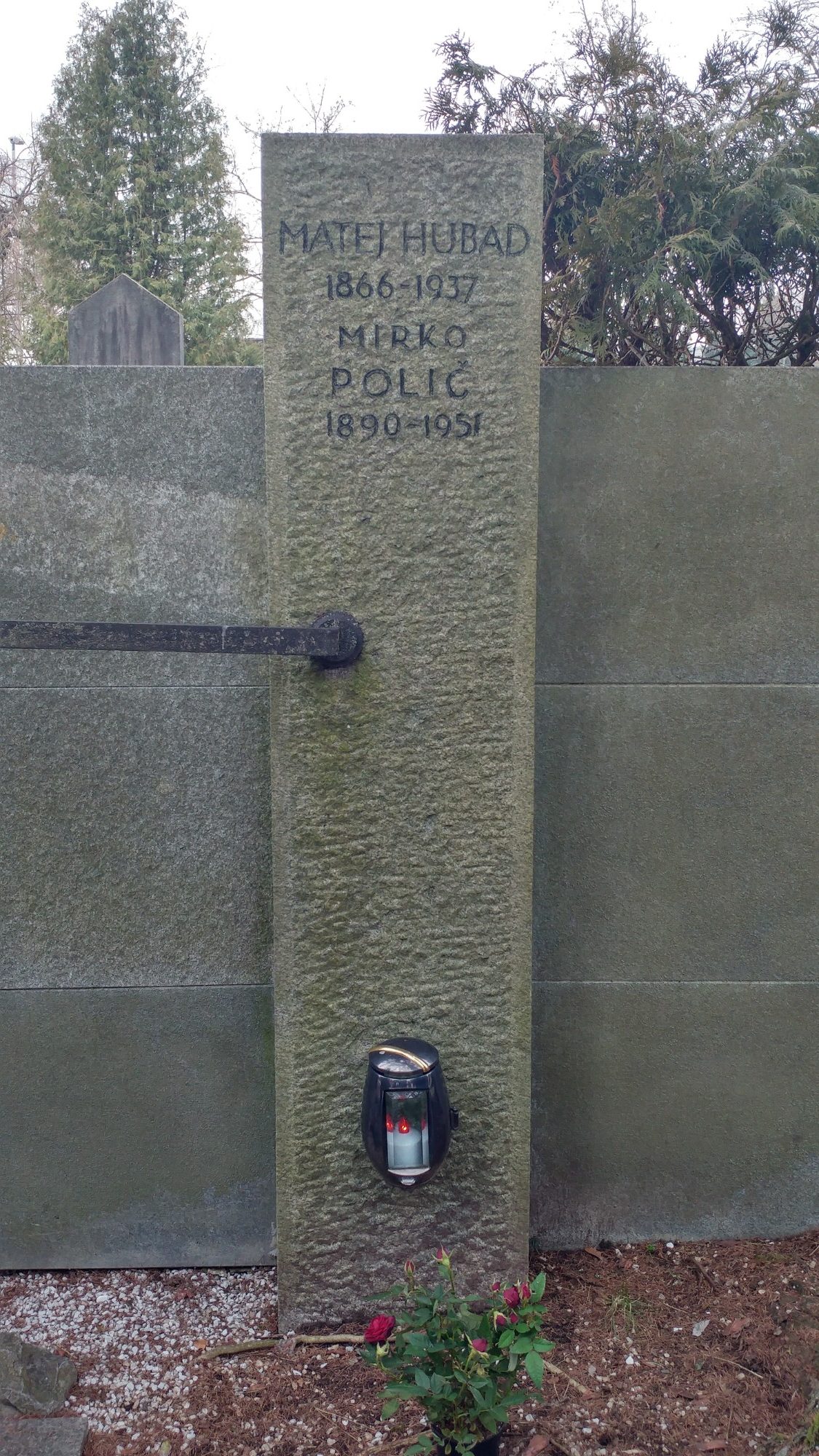A group memorial dedicated to Slovenian composers stands in Žale Cemetery in Ljubljana. Four columns bear inscriptions of the names and dates of the following musicians and composers: Emil Adamič, Matej Hubad, Zorko Prelovec, Vasilij Mirk, Anton Lajovic, Danilo Švara, Mirko Polič, Slavko Osterc, Marij Kogoj, Ferdo Juvanec and Ferdo Juvanec Senior. Placed in the centre is a bust of Davorin Jenko, a promoter of national awakening and composer, who was the catalyst for the decision of Glasbena matica Ljubljana to erect a memorial and have the cemetery constructed.
The idea for a memorial emerged at the beginning of the 1930s as a way to resolve the issue of the dilapidated municipal graveyard behind what was then the Church of St Christopher. It contained headstones of eminent Slovenians, which architect Jože Plečnik aimed to include in his imposing sanctuary of notable men and women of Slovenia. This pantheon was envisioned to stand in a park on the grounds of the old St Christopher’s graveyard. While the idea fell through, tributes to Slovenian heritage, partly according to Plečnik’s plan, were erected in separate locations – the memorials on the Avenue of Slovenian Composers, in Navje Park, on the building of the Glasbena matica Music Society and at Žale.
The Slovenian composers’ communal burial plot at Žale Cemetery traces its beginnings to the centennial of the birth of Davorin Jenko. In 1935, with the approach of Jenko’s anniversary, it was becoming clear that the composer’s final resting place was inappropriate, unbefitting and neglected. The efforts of Glasbena matica to attend to the restoration of the composer’s grave were suspended by the authorities of Gorenjska, seeking to have Jenko’s grave relocated to Kranj or to his native Cerklje. Thus, instead of a headstone, Matica was able to commemorate the anniversary of the composer’s birth only by erecting a memorial column in front of his house in Kolodvorska Street where Jenko died.
Afterwards, it was a Glasbena matica recording clerk, Karel Mahkota, who singlehandedly went about arranging the grave, preparing three burial plots behind the Church of St Cross, with a view to arranging Jenko’s grave first and then a communal cemetery for Slovenian composers. An entry in the minutes of a Glasbena matica Board meeting in 1936 states that behind the graveyard Church of St Cross “Jenko’s grave has been completely restored and designed according to plans by architect Spinčič” and that the composer’s bust had already been erected on the grave. It is held by some that this was the reason behind architect Plečnik’s decision to distance himself from any further cooperation with Glasbena matica in designing the composers’ burial place. Numerous remains were relocated from the old graveyard behind St Christopher’s Church (Navje) to the cemetery around the Church of St Cross, and in the 1930s the new location was declared Ljubljana’s main cemetery, the present-day Žale.
During World War II, pursuant to Matica’s decision, Slavko Osterc and Ferdo Juvanec Senior were buried in the composers’ section of the cemetery, and afterwards Marij Kogoj and Ferdo Juvanec Junior. Today, the Society of Slovenian Composers and the Glasbena matica Music Society jointly tend to the maintenance of the plot.
Maia Juvanc
Mirko Polič
A prominent Slovenian conductor in his time, Mirko Polič (1890–1951) went down in the history of the Ljubljana Opera as one of its most influential directors. He carved out a conducting career in the theatres of Trieste, Osijek, Zagreb and Belgrade, and was highly instrumental in developing the Ljubljana Opera, overhauling its repertoire by programming current opera works and introducing new approaches to stage direction and set design.
He graduated from grammar school in his native Trieste, and then studied law in Prague. Soon discontinuing his studies, Polič returned to Trieste, where he graduated from Conservatorio Verdi. Throughout his time as a student, he served as a choirmaster of the Slovenian Choral Society Trieste and of the local choir of the Šentjakob (San Giacomo) Reading Room. In 1911, Polič was appointed conductor of the Trieste National Theatre, introducing its first regular opera performances in 1913. In 1914, Polič went to Osijek, serving as the Osijek Opera’s conductor and becoming its director in 1918. In Osijek, Polič organised a civilian orchestra and established a music school. He was secretary and conductor of the Zagreb and Belgrade opera houses for a spell of several years, concurrently serving as conductor of the Stanković Choral Society in Belgrade.
In 1925, Matej Hubad appointed Polič director of the Ljubljana Opera, a post he held for the next fourteen years. He staged a number of new opera works, including Oedipus Rex by Stravinsky and The Tsar Has His Photograph Taken, an opera buffa by Kurt Weill. Giving special prominence to Slavic operas, some of the most notable productions staged at the Ljubljana theatre include Smetana’s The Bartered Bride, Janáček’s Jenufa (1934), Boris Godunov by Mussorgsky (1934) and Ero s onoga svijeta (Ero the Joker, 1937), a popular Croatian opera by Jakov Gotovac. Further successes include performances of Wagner’s Tannhäuser (1926), Die Walküre (The Valkyrie, 1929), Lohengrin (1930) and Parsifal (1933).
In implementing the theatre’s artistic vision, Polič displayed a special affinity for contemporary Slovenian operatic works. He expanded the repertoire with stagings of Lepa Vida (Beautiful Vida) and Matija Gubec by Risto Savin, Črne maske (Black Masks) by Marij Kogoj, Pohujšanje v dolini šentflorjanski (Scandal in the St Florian Valley) by Matija Bravničar and Medeja (Medea) by Slavko Osterc, and favoured progressive stage directors, including Bratko Kreft, Ferdo Delak and Osip Šest. A production running for a record twenty-three performances, For the Love of Three Oranges by Prokofiev, was director Osip Šest’s greatest success. Over the decade of 1926–1936, Polič took the Ljubljana Opera ensemble on tours to Yugoslavia, primarily Dalmatia; the most important appearances were in Trieste and Rijeka.
Seeking to modernise opera set design, Polič engaged fine artists, most notably Božidar Jakac. Polič was also instrumental in developing music in Slovenia by commissioning revisions of librettos and new translations from Niko Štritof and Oton Župančič.
Polič served as the conductor of the Glasbena matica Music Society Choir from 1929, that same year touring France and Switzerland, and later Bulgaria, with the ensemble. Under his leadership, the Glasbena matica Choir performed a number of challenging works, including Beethoven’s Symphony No. 9 (1927), Mozart’s Requiem (1930), Berlioz’s The Damnation of Faust (1930), Sattner’s symphony-cantata Oljki (To an Olive Tree, 1932), Gallus’ motets and madrigals (1932) and Osterc’s Magnificat (1936), as well as Foerster’s cantata Turki na Slevici (Turks in Slevica, 1937), which Polič rearranged with new instrumentation.
In 1939, he took up a conducting post at the Belgrade Opera, staging Škerjanc’s monumental symphony-cantata Zedinjenje (Unification) with the Glasbena matica Music Society Choir soon after beginning his tenure. With the outbreak of World War II, in 1941, Polič returned to Ljubljana and taught at the Glasbena matica Music School. Two large-scale symphony concerts and a cantata by Matija Tomc were performed under his baton in Ljubljana in 1941 and in 1943. Polič was re-appointed director of the Ljubljana Opera in 1945, holding this post until 1948. During his tenure, the Ljubljana Opera rose to new heights, heralding the first important era of the modernised repertoire in the history of Slovenian opera.
Polič was also a composer, writing primarily vocal music. His most notable works include Suita v antičnem slogu (A Suite in Antique Style) and an opera Mati Jugovičev (The Mother of the Jugovići). He revised the libretto and partly rewrote the music of Porin, an opera by Croatian composer Vatroslav Lisinski, publishing an extensive treatise on the piece in Hrvaški glas (Croatian Newsletter). He published articles, and served as editor of Kazališni list (Theatre Bulletin) in Osijek and, between 1929 and 1931, of Gledališki list (Theatre Bulletin) of the Slovenian National Theatre Opera and Ballet in Ljubljana.
In recognition of his significant accomplishments in advancing the Ljubljana Opera, Polič received the 1951 Prešeren Award for lifetime achievement in music as an artist and manager.
Maia Juvanc
Vasilij Mirk
Vasilij Mirk (1884–1962) was a composer, educator and choirmaster. He scored both secular and church music.
He attended grammar school in Trieste, and then studied philosophy, geography and history in Vienna and Graz, at the same time taking lessons in composition. He taught at a commercial school in Trieste, and later worked as a bank clerk. From 1928, he held a teaching post at the Commercial College in Maribor. During his employment in Trieste, he also taught piano, music theory, harmony, counterpoint and music history at the Glasbena matica School and at the music lyceum.
He made his mark as a choirmaster and wrote choral, piano, orchestral and vocal-instrumental compositions. Printed editions of his piano and vocal works include Klavirske skladbe (Piano Pieces, 1921), Mladinski album za klavir (Youth Album for Piano, 1924), Deset povesti za slovensko klavirsko mladino (Ten Tales for Slovenian Piano Youth, 1927) and Samospevi (Lieder, 1929). Several of his choral pieces were published in Novi akordi, Zbori, Pevcu (New Chords, Choirs, To a Vocalist) and in editions of Glasbena matica Trieste. In 1929, in commemoration of the 10th anniversary of the Glasbena matica Music Society in Maribor, he scored Golgota (Golgotha) for choir and orchestra and Mornarska (Seafaring Song) for male choir. Some of his most noteworthy church compositions are Staroslovenska maša (Old Church Slavonic Mass) for eight-part chorus, and Liturgija sv. Ivana Zlatoustega (Liturgy of St John Chrysostom), which forms part of the Trieste Orthodox Church repertoire.
Maia Juvanc
Ferdo Juvanec
Teacher and musician Ferdo Juvanec (1872–1941) worked first in Cerknica near Rakek, then as a head teacher in Postojna, and later served on the higher school board in Ljubljana. As well as an educator, he was also a choral composer. He wrote music for male, female and mixed choirs, and also lieder and theatre music.
He studied harmony and counterpoint under Anton Nedvěd, and started out on his musical career in 1890 at a teacher-training college, where he composed short songs for four-part choir and conducted the student choir. In Postojna, Juvanec formed a choir and salon orchestra, and in Ljubljana the Teachers’ Mixed Choir, which he conducted in concerts at various Ljubljana venues, around the border regions of northern Slovenia, in Prekmurje and Metlika, in Belgrade, Novi Sad and further abroad.
His compositions are marked by melodiousness. His most notable choral works are Spomin na zimski večer (Recollection of a Winter Evening), compositions for male choir Slovenska zemlja, Pastir, Rožici, Rožmarin, Molitev neodrešenih (Slovenian Land, Shepherd, To a Rose, Rosemary, Prayer of the Unredeemed) and works for mixed choir Na goro and Izgubljeni cvet (Up a Mountain, Lost Blossom). He edited the Manual of Singing and Theory by Ivanka Negro-Hrastova (Ljubljana 1924) and set to music several nursery rhymes.
Maia Juvanc
Ferdo Juvanec ml.
Ferdo Juvanec Jr. (1908–1978) was a Slovenian composer, teacher and musician. He taught music in Ljubljana, Maribor, Novo mesto and Ptuj. From 1953, Juvanec Jr. was a member of the Slovenian Philharmonic Orchestra. He composed mainly chamber music.
Maia Juvanc
Davorin Jenko
You can read the biography HERE.
Matej Hubad
You can read the biography HERE.
Emil Adamič
You can read the biography HERE.
Anton Lajovic
You can read the biography HERE.
Danilo Švara
You can read the biography HERE.
Zorko Prelovec
You can read the biography HERE.
Slavko Osterc
You can read the biography HERE.
Marij Kogoj
You can read the biography HERE.
